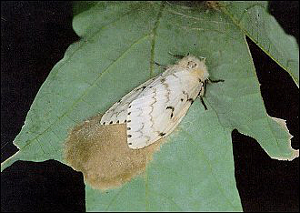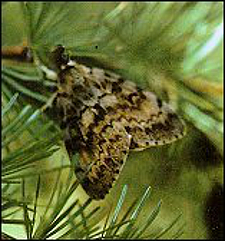 |
Though not a current threat in the western states, gypsy moth is a serious problem in the eastern states, where millions of acres of trees and shrubs can be defoliated in a single outbreak.
The gypsy moth, Lymantria dispar Linnaeus, is one of the most notorious pests of hardwood trees in the Eastern United States. Since 1980, it has defoliated close to a million or more forested acres each year. In 1981, a record 12.9 million acres were defoliated. This is an area larger than Rhode Island, Massachusetts, and Connecticut combined.
In wooded suburban areas, during periods of infestation when trees are visibly defoliated, gypsy moth larvae crawl up and down walls, across roads, over outdoor furniture, and even inside homes. During periods of feeding they leave behind a mixture of small pieces of leaves and frass, or excrement.
 |
| Gypsy moth larva |
The gypsy moth is not a native insect. It was introduced into the United States in 1869 by a French scientist living in Massachusetts. The first outbreak occurred in 1889. By 1987, the gypsy moth had established itself throughout the Northeast. The insect has spread south into Virginia and West Virginia, and west into Michigan. Infestations have also occurred in Utah, Oregon, Washington, California, and many other states outside the Northeast.
The effects of defoliation depend primarily on the amount of foliage that is removed, the condition of the tree at the time it is defoliated, the number of consecutive defoliations, available soil moisture, and the species of host.
Trees use energy reserves during refoliation and are eventually weakened. Weakened trees exhibit symptoms such as dying back of twigs and branches in the upper crown and sprouting of old buds on the trunk and larger branches. Weakened trees experience radial growth reduction of approximately 30 to 50 percent.
 |
| Female gypsy moth laying eggs |
Although not preferred by the larvae, pines and hemlocks are subject to heavy defoliation during gypsy moth outbreaks and are more likely to be killed than hardwoods. A single, complete defoliation can kill approximately 50 percent of the pines and 90 percent of the mature hemlocks.
A number of tactics have the potential to minimize damage from gypsy moth infestations and to contain or maintain gypsy moth populations at levels considered tolerable. These tactics include monitoring gypsy moth populations, maintaining the health and vigor of trees, discouraging gypsy moth survival, and treating with insecticides to kill larvae and protect tree foliage.
The traps you see around detect where the moth is or isn’t. If moths are found in a trap, a treatment decision can then be made to eradicate a small local population.
 |
| Male gypsy moth |
Homeowners might want to consider one or more of the following tactics when gypsy moth populations are sparse. These activities do not guarantee a reduction or elimination of gypsy moth populations, nor will the activities guarantee to reverse the trend of an infestation of the gypsy moth. These activities are more practical for homeowners to use on individual yard trees than for land managers to use in forest stands.
* Remove objects around the outside of the home that provide shelter for gypsy moth larvae and pupae, such as flaps of bark, dead tree branches, dead trees, boxes, cans or old tires.
* Diversify the composition of trees and plants on your property to include species not preferred by the gypsy moth, such as tulip or yellow poplar, honeylocust, ash, hickory, dogwood, mountain ash, and many conifers.
* Destroy egg masses found on outbuildings, on fencing, and in woodpiles. Simply scraping egg masses onto the ground will not destroy them. Burn them or soak them in kerosene or soapy water. Caution is urged because the hairs that coat the egg masses can cause allergic reactions. Egg masses can also be destroyed by planting them with commercially available products, such as liquid detergents.
* Place burlap on trees, especially oaks, to provide shade and shelter for older larvae when they seek out protected resting places during the day. The number of larvae and pupae that rest under the burlap provides valuable information about the severity of infestation on your property. When populations are sparse, larvae and pupae beneath burlap can be manually destroyed.
* Use barrier bands, consisting of commercially available double-sided sticky tapes, or sticky material such as Tanglefoot, petroleum jelly, or grease, to prevent larvae from crawling up the trunks of susceptible trees. These products should be applied to the surface of an impermeable material, such as duct tape or tar paper, and not applied directly to the bark. Petroleum-based products can cause injury (swelling and cankering) on thin-barked trees.
Homeowners can get advice about identifying and controlling the gypsy moth through the County Cooperative Extension Service, the State Entomologist or State Forester, or from specialists at the State University or Agricultural Experiment Station.